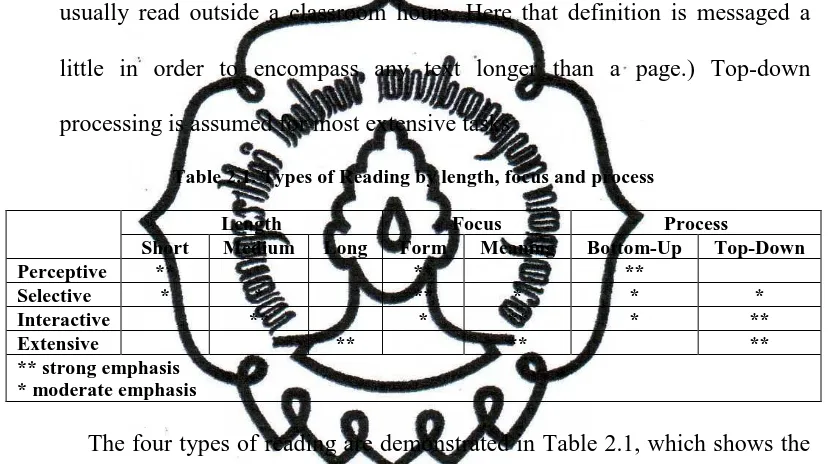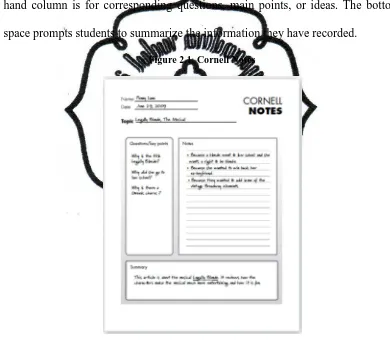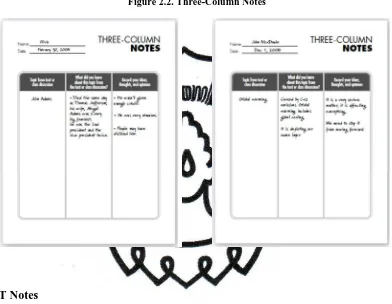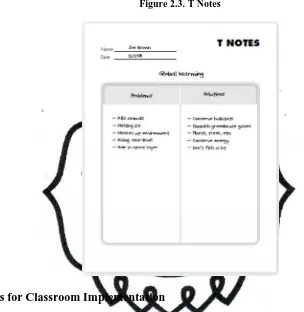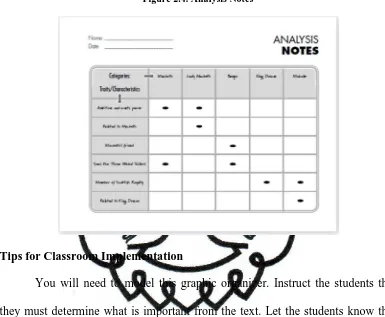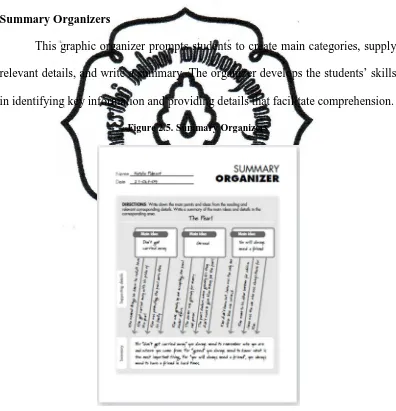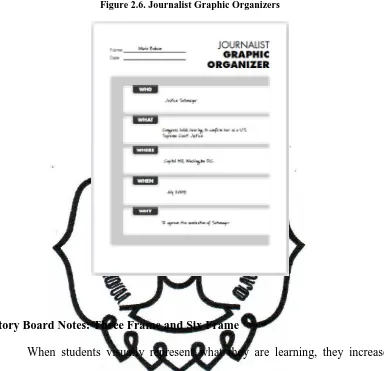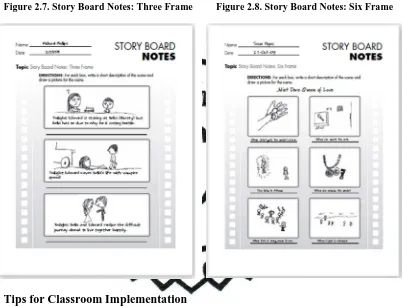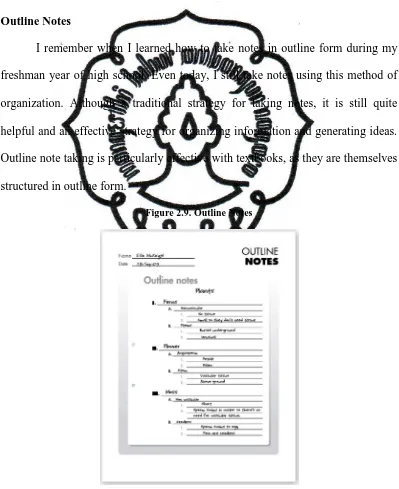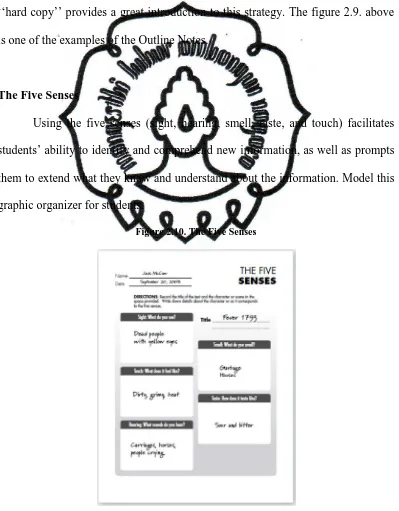commit to user
THE INFLUENCE OF NOTE-TAKING PAIRS TECHNIQUE
AND STUDENT’S LINGUISTIC INTELLIGENCE
UPON STUDENT’S READING COMPETENCE
An Experimental Research at STKIP–PGRI Pontianak, 2011/2012
THESIS
Written as Partial Fulfillment of The Requirements for Getting The Master Degree of English Education Department
BY:
FINNY ANITA
NIM. S891008031
GRADUATE SCHOOL
SEBELAS MARET UNIVERSITY
SURAKARTA
commit to user
i
THE INFLUENCE OF NOTE-TAKING PAIRS TECHNIQUE
AND STUDENT’S LINGUISTIC INTELLIGENCE
UPON STUDENT’S READING COMPETENCE
An Experimental Research at STKIP-PGRI Pontianak, 2011/2012
THESIS
By:
FINNY ANITA NIM. S891008031
Supervisor Commission
Name Signature Date
Supervisor I Prof. Dr. H. Joko Nurkamto, M.Pd NIP. 19610124 198702 1 001
__________ __ July 2012
Supervisor I Drs. Gunarso Susilohadi, M.Ed, TESOL NIP. 19540315 198503 1 002
__________ __ July 2012
This thesis has been approved as partial fulfillment of the requirements for getting the Master Degree of English Education Department
on __ July 2012
The Head of Graduate Program of English Education Department of Sebelas Maret University
commit to user
ii
THE INFLUENCE OF NOTE-TAKING PAIRS TECHNIQUE
AND STUDENT’S LINGUISTIC INTELLIGENCE
UPON STUDENT’S READING COMPETENCE
An Experimental Research at STKIP-PGRI Pontianak, 2011/2012
THESIS
Chairman Dr. Abdul Asib, M.Pd. NIP. 19520307 198003 1 005
_____________ __ July 2012
Secretary Dra. Dewi Rochsantiningsih, M.Ed., Ph.D. NIP. 19600918 198702 2 001
_____________ __ July 2012
Examiner I Prof. Dr. H. Joko Nurkamto, M.Pd. NIP. 19610124 198702 1 001
_____________ __ July 2012
Examiner II Drs. Gunarso Susilohadi, M.Ed, TESOL NIP. 19540315 198503 1 002
_____________ __ July 2012
This thesis has been examined by the Board of Thesis Examiners as partial fulfillment of the requirements for getting the Master Degree
of English Education Department on __ July 2012
The Director of Graduate School
Prof. Dr. Ir. Ahmad Yunus, M.S. NIP. 19610717 198601 1 001
The Head of English Education Department
commit to user
iii
PRONOUNCEMENT
This is to certify that I myself write this thesis entitled: The Influence of Note-Taking Pairs Technique and Student’s Linguistic Intelligence upon Student’s
Reading Competence (An Experimental Research at STKIP-PGRI Pontianak,
2011/2012). It is not plagiarized or made by others. Anything related to others’ works are written in quotation, the source of which is listed on the bibliography.
If then this pronouncement is proven incorrect, I am ready to accept any academic punishment, including the withdrawal or cancelling of my academic degree.
Surakarta, 26th July, 2012
commit to user
iv
MOTTO
MAN JADDA WAJADA
= Anyone who is serious, then he will succeed =
commit to user
v
DEDICATION
With deepest profound love, this work is devoted to:
commit to user
vi
ABSTRACT
Finny Anita, S891008031. 2012. The Influence of Note-Taking Pairs Technique and Student’s Linguistic Intelligence upon Student’s Reading Competence (An Experimental Research at STKIP-PGRI Pontianak, 2011-2012). THESIS. Supervisor I: Prof. Dr. Joko Nurkamto, M.Pd., Supervisor II: Drs. Gunarso Susilohadi, M.Ed. TESOL. English Education Department, Graduate School, Sebelas Maret University, Surakarta.
The aims of this research are to investigate whether: (1) in general, there is a difference on reading competence between the students who are taught using Note-Taking Pairs technique and Directed Reading – Thinking Activity (DR-TA) technique; (2) in general, there is a difference on reading competence between the students having high linguistic intelligence and the students having low linguistic intelligence; (3) there is an interaction effect between the teaching techniques and student’s linguistic intelligence in terms of reading competence.
This research was carried out at STKIP-PGRI Pontianak. The population of the research is the evening class of the second semester students of English Education Study Program, consists of 98 students. Cluster random sampling was used to get the sample. The sample used in this research is 30 students of class C as the experimental class and 30 students of the class B as the control class. The techniques of collecting data in this research are tests (reading test and linguistic intelligence test). The linguistic intelligence test was used to group the students into high level and low level of linguistic intelligence. After treatment was given in twelve meetings, the post-test of reading test was conducted to get the research data. ANOVA 2x2 (F-test) and Tukey test were used to analyze the data after the tests of data analysis prerequisite (the normality test and the homogeneity test) were fulfilled.
Based on the result of data analysis, the research findings are: (1) in general, there is a difference on reading competence between the students who are taught using Note-Taking Pairs technique and DR-TA technique; (2) in general, there is a difference on reading competence between the students having high linguistic intelligence and students having low linguistic intelligence; (3) there is an interaction effect between the teaching techniques and student’s linguistic intelligence in terms of reading competence.
Finally, the research findings imply that the use of Note-Taking Pairs technique can influence the student’s reading competence. Therefore, it is recommended that English teachers/lecturers are applying Note-Taking Pairs technique in teaching reading comprehension. The students are suggested to apply Note-Taking Pairs technique to get better reading competence, so they will be more skillful in comprehending various reading materials.
commit to user
vii
ACKNOWLEDGEMENT
Her greatest gratitude is present to Allah that the researcher is able to complete this thesis as a partial fulfillment of the requirements for getting the graduate degree of English education. The writer realizes that she gets a lot of helps from many parties. In this good opportunity, she would like to express her sincerest thanks and appreciation to:
1. The Director of Graduate School of Sebelas Maret University who has given the opportunity to conduct the research.
2. The Head of English Education Department of Graduate School who has supported and helped her in composing the thesis.
3. Her supervisors, Prof. Dr. Joko Nurkamto, M.Pd. and Drs. Gunarso Susilohadi, M.Ed. TESOL., who have encouraged her patiently and wisely in exploring the research and guided her to finish the thesis.
4. The Head of STKIP-PGRI Pontianak, Prof. Dr. H. Samion. A.R., M.Pd., who has granted the scholarship for her to experience the further study and has allowed her to carry out the research in the college.
5. The students of English Education Study Program of STKIP-PGRI Pontianak for giving valuable research data.
6. Her classmates for the awesome discussions and supports.
7. The people who are not mentioned here, but have contributed either directly or indirectly to the completion of this thesis.
Finally, the researcher realizes that this thesis is not perfect yet, therefore, constructive suggestion is needed for progress of the next study.
The researcher,
commit to user
LIST OF ABBREVIATION ……… xiii
LIST OF APPENDICES ………. xiv
CHAPTER I INTRODUCTION ………... 1
A. Background of the Study ………... 1
B. Problem Identification ………... 9
C. Problem Limitation ………... 10
D. Problem Statement ……… 10
E. The Objectives of the Study ……….. 11
F. The Benefits of the Study ……….. 12
CHAPTER II REVIEW OF RELATED LITERATURE ………... 14
A. Reading Competence ……….. 14
1. Definition ……….. 14
2. Purpose of Reading ………... 17
3. Skills for Reading Competence ………. 19
4. Model of Reading ……… 20
commit to user
ix
B. Theoretical Description ………. 25
1. Technique of Teaching Reading ………. 25
2. Note-Ta Taking Pairs Technique ………... 26
a. The Nature of Note-Taking Pairs ……… 26
b. The Teaching Steps of Note-Taking Pairs ………. 46
c. The Advantages of Note-Taking Pairs ……… 48
d. The Disadvantages of Note-Taking Pairs ………... 49
3. Directed Reading-Thinking Activity Technique ……….. 51
a. The Nature of Directed Reading-Thinking Activity ..….… 51
b. The Teaching Steps of Directed Reading-Thinking Activity 53 c. The Advantages of Directed Reading-Thinking Activity …. 62 d. The Disadvantages of Directed Reading-Thinking Activity 63 4. Teaching Reading Using Note-Taking Pairs Technique Compared to Directed Reading – Thinking Activity Technique 63 C. Linguistic Intelligence ………. 66
1. The Nature of Intelligence ……… 66
2. The Nature of Linguistic Intelligence ………... 69
D. Previous Relevant Studies ………. 74
E. Rationale ………... 77
F. Hypotheses ……… 82
CHAPTER III RESEARCH METHODOLOGY ……… 83
A. The Place and Time of Research ………... 83
B. The Method of the Research ………. 84
C. Population, Sample, and Sampling ………... 86
D. The Technique of Collecting Data ……… 87
E. The Technique of Analyzing Data ……… 90
commit to user
x
CHAPTER IV THE RESULT OF THE STUDY……… 102
A. Data Description ………..………... 102
B. Test of Data Analysis Prerequisite ..……… 111
1. The Normality Test ………... 112
2. The Homogeneity Test ……….. 114
C. Hypothesis Testing ……….. 115
1. Multifactor of Analysis of Variance 2 x 2 ……… 115
2. Tukey Test ………. 118
D. Discussion ……… 121
CHAPTER V CONCLUSION, IMPLICATION, AND SUGGESTION 128 A. Conclusion ……….. 128
B. Implication ……….. 129
C. Suggestion ……….. 130
BIBLIOGRAPHY ………. 132
commit to user
xi
LIST OF TABLES
Table 1.1. The Average Scores and Percentage of Correct Answers of
Each Section in TOEFL Test ……… 4
Table 2.1. Types of Reading by Length, Focus and Process ……… 24
Table 2.2. General Category of Note-Taking Pairs and DR-TA ………. 64
Table 2.3. The Example of Teaching Techniques in Classroom Context 64 Table 3.1. The Schedule of the Research ……….. 83
Table 3.2. 2 x 2 Factorial Design ……….. 86
Table 3.3. 2 x 2 Multifactor Analysis of Variance ……… 95
Table 3.4. The Summary of a 2 x 2 Multifactor Analysis of Variance …. 98 Table 4.1. Frequency Distribution of A1 ………. 103
Table 4.2. Frequency Distribution of A2 ………. 104
Table 4.3. Frequency Distribution of B1 ………. 105
Table 4.4. Frequency Distribution of B2 ………. 106
Table 4.5. Frequency Distribution of A1B1 ………. 107
Table 4.6. Frequency Distribution of A1B2 ………. 109
Table 4.7. Frequency Distribution of A2B1 ………. 110
Table 4.8. Frequency Distribution of A2B2 ………. 111
Table 4.9. The Normality Test ……… 114
Table 4.10. The Homogeneity Test ……….. 115
Table 4.11. Multifactor Analysis of Variance 2 x 2 ………. 116
commit to user
xii
LIST OF FIGURES
Figure 2.1. Cornell Notes ………..……….. 32
Figure 2.2. Three-Column Notes ………... 34
Figure 2.3. T Notes ……… 35
Figure 2.4. Analysis Notes ……… 36
Figure 2.5. Summary Organizers ………... 37
Figure 2.6. Journalist Graphic Organizers ...………... 39
Figure 2.7. Story Board Notes: Three-Frames ……….. 40
Figure 2.8. Story Board Notes: Six-Frames ……….. 40
Figure 2.9. Outline Notes ……… 41
Figure 2.10. The Five Senses ………...………. 42
Figure 2.11. Cycle or Food Chain …..……… 43
Figure 2.12. Spidergrams …….………. 45
Figure 4.1. Histogram and Polygon of Data A1 ……… 104
Figure 4.2. Histogram and Polygon of Data A2 ……… 105
Figure 4.3. Histogram and Polygon of Data B1 ……… 106
Figure 4.4. Histogram and Polygon of Data B2 ………... 107
Figure 4.5. Histogram and Polygon of Data A1B1 ……… 108
Figure 4.6. Histogram and Polygon of Data A1B2 ……… 109
Figure 4.7. Histogram and Polygon of Data A2B1 ……… 110
commit to user
xiii
LIST OF ABBREVIATION
DR-TA : Directed Reading – Thinking Activity
IELTS : International English Language Testing System Sisdiknas : Sistem Pendidikan Nasional
STKIP-PGRI : Sekolah Tinggi Keguruan dan Ilmu Pendidikan – Persatuan Guru Republik Indonesia
commit to user
xiv
LIST OF APPENDICES
Instrument: Rencana Pelaksanaan Pembelajaran (RPP)
Appendix 1. Rencana Pelaksanaan Pembelajaran (RPP): Experimental Group & Control Group ….………... 136 Instrument: Linguistic Intelligence Test
Appendix 2.a. Blue Print of Linguistic Intelligence Test (Try-out: 100
items) ……… 219
Appendix 2.b. Linguistic Intelligence Test (Try-out: 100 items) …….. 221 Appendix 2.c. Answer Key of Linguistic Intelligence Test (Try-out: 100
items) ……….………... 232
Appendix 2.d. Validity of Linguistic Intelligence Test ………... 234 Appendix 2.e. Reliability & Level of Difficulty (P) of Linguistic
Intelligence Test ……….……….. 237
Appendix 2.f. Discriminating Index/Discriminating Power (D) of Linguistic Intelligence Test ...……….. 239 Appendix 2.g. Blue Print of Linguistic Intelligence Test (Post-test: 50
items) ……… 241
Appendix 2.h. Linguistic Intelligence Test (Post-test: 50 items) ………. 243 Appendix 2.i. Answer Key of Linguistic Intelligence Test (Post-test: 50
items) ……… 250
Instrument: Reading Test
Appendix 3.a. Blue Print of Reading Test (Try-out: 100 item ………… 251 Appendix 3.b. Reading Test (Try-out: 100 items) ……….. 253 Appendix 3.c. Answer Key of Reading Test (Try-out: 100 items) …... 271 Appendix 3.d. Validity of Reading Test ………... 272 Appendix 3.e. Reliability & Level of Difficulty (P) of Reading Test … 275 Appendix 3.f. Discriminating Index/Discriminating Power (D) of
Reading Test ...……….. 277
Appendix 3.g. Blue Print of Reading Test (Post-test: 50 items) ………… 279 Appendix 3.h. Reading Test (Post-test: 50 items) ……….…. 281 Appendix 3.i. Answer Key of Reading Test (Post-test: 50 items) …….. 290 Data Analysis
Appendix 4.a. The Result of Linguistic Intelligence Test & Reading Test: Experimental Group & Control Group ………….. 291
Appendix 4.b. Normality Test ………. 292
Appendix 4.c. Homogeneity Test ………. 298 Tables
Appendix 5.a. Nilai-Nilai r Product Moment ……….. 299 Appendix 5.b. Standard Normal Distribution ………. 300 Appendix 5.c. Critical Values for Lilliefors Test for Normality ……… 301 Appendix 5.d. Chi Squared Distribution ………. 302
Appendix 5.e. F Distribution ……… 303
commit to user
1 CHAPTER I
INTRODUCTION
A. Background of the Study
The objective of a Study Program is reflected in the competence standard of the institution. The competence standard of higher education graduates is developed by the institution itself based on vocational, and/or professional characteristic of the academic Study Program. It is stated in Peraturan Pemerintah Republik Indonesia, No.19, 2005 about Standar Nasional Pendidikan, Pasal 27, Ayat 2, “Standar kompetensi lulusan pendidikan tinggi ditetapkan oleh masing-masing perguruan tinggi.”
English subject is stated as one of the compulsory subjects in higher education institution. According to both Undang-Undang Republik Indonesia, No.20, 2003 about Sistem Pendidikan Nasional (Sisdiknas), Pasal 37, Ayat 2(c); and Peraturan Pemerintah Republik Indonesia, No.19, 2005 about Standar Nasional Pendidikan, Pasal 9, Ayat 2, “Kurikulum tingkat satuan pendidikan tinggi wajib memuat mata kuliah Pendidikan Agama, Pendidikan Kewarganegaraan, Bahasa Indonesia, dan Bahasa Inggris.”
commit to user
It is stated in the curriculum of English Education Study Program of STKIP-PGRI Pontianak that Reading is one of the compulsory subjects which is taught within three semesters. There are: Reading I, Reading II and Reading III. Acquiring a good skill in comprehending reading text is important for the students. It will help the students with a clear understanding of what the writer intends to convey. According to Breznitz in Grabe (2009: 15),
Reading is an interaction between the reader and the writer. The text provides information that the author wants the reader to understand in certain ways. The reader also brings a wide range of background knowledge to reading, and she or he actively constructs the meaning of the text by comprehending what the writer intends and by interpreting it in term of background knowledge activated by the reader.
The objective of teaching Reading subjects as stated in the curriculum of the English Education Study Program of STKIP-PGRI Pontianak is to train the students to be able to get the reading competences, such as: getting the word meaning of the text, stating or formulating the main idea of the text, identifying detail information from the text by considering the transition signals, identifying the reference from the text, differentiating the style of paragraph development, and speed reading using skimming and scanning. Students are expected to get all those competences from varied types of the reading texts namely; short functional text, dialog text, and monolog text.
commit to user
have wider opportunity to get good position in the society since he or she has an excellent skill in immediately grasping information than others.
Students who have the good reading competences will get benefits in seeking information from internet, magazines, newspapers, journals, and so on. According to Pang, et al. (2003: 6),
Learning to read is an important educational goal. The ability to read opens up new worlds and opportunities. It enables us to gain new knowledge, enjoy literature, and do everyday things that are part and parcel of modern life, such as, reading the newspapers, job listings, instruction manuals, maps and so on.
Reading is a key to improve learning outcome in many fields of study. Students need to read numerous sources of reading materials to broaden their knowledge in whatever their areas of interest are. Pang, et al. (2003: 20) state, “It is well established that good readers read with ease, accuracyand understanding. Good readers also read more, and byreading more, they increase their vocabulary and knowledge.”
Furthermore, by comprehending many reading materials, students get not only the knowledge in their mind but also numerous advantages. Reading is a skill that will empower everyone who learnsit. They will be able to benefit from the store of knowledge in printed materials and, ultimately, to contribute to that knowledge. Good teaching enables students to learn to read and read to learn. (Pang, et al. 2003: 21).
commit to user
generally provide the information which the readers need. However, many have difficulties in comprehending the reading text. Some consider it as the most challenging skill indeed. Some even frequently get the reading score as the lowest one than the others skill’s score. The low score of reading test section in Test of English as a Foreign Language (TOEFL) and/or International English Language Testing System (IELTS) test of Indonesian graduates make this condition worse.
This is confirmed by the data gained from a research report conducted by I. Made Sujana, et al. (2011) that from the three sections of TOEFL test, the student’s listening proficiency has the highest score with the average score of 462 (students correctly answered 46% of the test items of listening section). Then, the structure & written expression section with the average score of 435 (students correctly answered 45% of the test items of structure & written expression section). The reading comprehension section has the lowest score with the average score of 417 (students correctly answered 42% of the test items of reading comprehension section). The result is described in the Table 1.1. below.
Table 1.1. The Average Scores and Percentage of Correct Answers of Each Section in TOEFL test.
Section Average score Percentage of correct
answers of test items
Listening Comprehension 462 46%
Structure & Written Expression 435 45%
Reading Comprehension 417 42%
commit to user
The ability of Indonesian students to read English text is very crucial, especially for students at the higher education level. Most university graduates are not able to read English with complete understanding. English students at higher education are expected to read or comprehend English text books of different fields of study.
English as one of the foreign language in Indonesia can be used as language of instruction in particular education units to support the student’s ability on foreign language. As it is stated in Undang-Undang Republik Indonesia, No.20, 2003 about Sistem Pendidikan Nasional (Sisdiknas), Pasal 33, Ayat 3, “Bahasa asing dapat digunakan sebagai bahasa pengantar pada satuan pendidikan tertentu untuk mendukung kemampuan berbahasa asing peserta didik.”
There are several factors that might affect the student’s reading competences. In outline those factors can be grouped into two aspects: internal and external. The internal factors include the student’s learning motivation, learning interest, intelligence, talent, reading habit, creativity, self-esteem, and so on. Meanwhile, the external factors include the teacher qualification, learning material, English as the foreign language, difficulty level of test, facilities and infrastructure, school or institution authority, teaching media, teaching method, teaching technique, and so on.
commit to user
to the English culture may also cause the problem. The ignorance of summarizing or taking notes from the reading text makes the student’s comprehension of the text worse.
Although it seems that the readers or the students need no effort in reading, reading with comprehension involves a very complicated process for them. It is stated by Breznitz in Grabe (2009: 14),
When we read, we coordinate rapid and automatic word recognition, syntactic parsing, meaning formation, text-comprehension building, inferencing, critical evaluation, and linkages to prior knowledge resources. We do this seemingly without effort and with all processes synchronizing in time.
Considering this condition, it is necessary to involve those factors above in enhancing student’s reading competence. However, in this research, the researcher focuses only on the teaching techniques and the student’s linguistic intelligence. By teaching the students with appropriate teaching technique, it is assumed that the student’s reading competence will be better. The teacher provides the students with good reading competences to get clear information from the reading text by using the proper teaching technique. By considering the different level of the student’s linguistic intelligence, the teacher also must consider to carefully choose the appropriate teaching technique for the different groups of the students.
commit to user
During reading the text, the teacher periodically stops the reading activity at certain parts and asks the students confirmation about their prediction. Then, the students are asked to think and predict the information of the next part of the reading text.
Although in using this teaching technique, the students are required to have a good thinking skill; the activities in the class are under the teacher’s control and the students work individually although they are in group form. These activities should be more appropriate for the students who still need the guidance of the teacher. This technique may suit to certain students but many will fail. Student’s verbal/linguistic intelligence and cultural background take crucial roles in using this teaching technique. According to Manzo and Manzo (1990: 104), “Directed Reading-Thinking Activity (DR-TA) technique works for only a small percentage of students, not for a great variety. The students who have other than ‘verbal’ intelligence, or who come from different culture world views will fail.”
commit to user
lot of new knowledge and you need to develop reliable mechanisms for recording and retrieving it when necessary.” (University of Reading, 2011).
In using Note-Taking Pairs to teach reading skill in the class, teacher asks the students to read the text individually. After reading or whilst reading, the students are taking notes of the major points of the reading materials. In pairs, then, the students offer correction and additional information each other. Sort of these activities encourage the students to do the task collaboratively. Teacher’s role are as the activity designer, model, motivator, feedback giver, and monitor in developing the student’s ability in taking notes from the reading materials; thus they are expected have a better reading competence.
Several studies on Note-Taking technique conducted were proposed to know the students participation by I. A. Olaofe (1994); to provide Note-Taking guideline by Marianela Najul and Giancarla Marchi (1994) and Clara Perez Fajardo (1996); to help students achieving a better understanding of what is presented by Amirullah Khan (1999); and to investigate the influence to the students’ external condition by Akio Oshiro (2010), et al.
Both good thinking skill and note-taking skill are substantial to be acquired by the students, especially in the higher education level. Thus, these skills are strongly recommended to be involved in teaching and learning process. However, it cannot be denied that different level of student’s linguistic intelligence will bring different effect on the student’s ability on these skills.
commit to user
do with words, spoken or written. “People with linguistic intelligence love and are talented with words. They enjoy reading, writing and learning languages. They have an ability to teach and explain things to others. They learn best by reading, taking notes and going to lectures.” (My Personality, 2007).
In this study, the researcher conducted a research to prove the theories; whether Note-Taking Pairs and DR-TA as the reading teaching techniques can affect the student’s reading competence based on the different level of the student’s linguistic intelligence. Then, it was also to know whether this condition brought the same effect when it was applied in STKIP-PGRI Pontianak.
Thus, the research conducted was an experimental research entitled: The Influence of Note-Taking Pairs Technique and Student’s Linguistic
Intelligence upon Student’s Reading Competence towards the second semester
students of English Education Study Program of STKIP-PGRI Pontianak in the academic year of 2011/ 2012.
B. Problem Identification
Based on the background of the study, there are many problems that arise. The problems can be identified as follows:
1. Why do the students have low scores in reading test?
2. What factors cause the student’s low understanding of the reading text? 3. Do teaching techniques influence the student’s reading competence?
commit to user
5. Do students who taught using Note-Taking Pairs technique have better reading competence than students who are taught using DR-TA technique? 6. Is there any difference in reading competence between the students having
high linguistic intelligence and the students having low linguistic intelligence?
7. Do students having high linguistic intelligence have better reading competence than students having low linguistic intelligence?
8. Does the students’ linguistic intelligence influence their reading competence? 9. Is there any interaction between teaching techniques and student’s linguistic
intelligence in terms of reading competence?
C. Problem Limitation
The researcher realizes that it is impossible to answer all the problems, therefore, the researcher only limits the problems of the research, those are: the teaching techniques used by the teacher (Note-Taking Pairs and DR-TA), and the students’ linguistic intelligence.
D. Problem Statement
From the background of the study, problem identification, and problem limitation above, the researcher formulates the problems of the study as follows:
commit to user
If there is a difference, which group of students have a better reading competence?
2. In general, is there any difference on reading competence between the students having high linguistic intelligence and the students having low linguistic intelligence?
If there is a difference, which group of students have a better reading competence?
3. Is there any interaction between teaching techniques (Note-Taking Pairs and DR-TA) and student’s linguistic intelligence in terms of reading competence?
E. The Objectives of the Study
This research is aimed at finding out the influences of the teaching techniques and the student’s linguistic intelligence on the student’s reading competence. In accordance with the problems that have been defined, therefore this research is specially intended:
1. To investigate, in general, whether there is a difference on reading competence between the students who are taught using Note-Taking Pairs technique and DR-TA technique and to identify which group of students have a better reading competence.
commit to user
3. To investigate whether there is an interaction between teaching techniques (Note-Taking Pairs and DR-TA) and student’s linguistic intelligence in terms of reading competence.
F. The Benefits of the Study
The research is expected to be able to give some beneficial contributions to the researcher herself, for the students, for the teachers, lecturers and educators, and for the other educational researchers.
1. For the researcher herself
By conducting this study, it would increase the researcher’s own knowledge on how the reading comprehension is taught to the students and how to measure the students’ competence on their reading activity.
2. For the students
commit to user 3. For the teachers, lecturers and educators
First, this research can be one of the references for better teaching performance and technique. Second, this research can provide an illustration of preparing and experiencing a successful foreign language reading competence (as the alternative for the teacher’s technique in teaching reading).
4. For other educational researchers
commit to user
14 CHAPTER II
REVIEW OF RELATED LITERATURES
A. Reading Competence
1. Definition
Numerous researchers define reading in a slight different formula or it can be said that their ideas are quiet similar. The first impression derived from those definitions is that reading is related to the word meanings from the text; print and visual forms, especially when reading means comprehending the text itself. According to Grabe and Stoller (2002: 19), “If we cannot understand any words, we are not going to comprehend the text.”
As stated by Nation (2009: 9), “An essential part of the reading skill is the skill of being able to recognise written forms and to connect them with their spoken forms and their meanings. This involves recognising known words and also deciphering unfamiliar words.”
Simply put, reading is making meaning from print and from visual information. But reading is not simple. Reading is an active process that requires a great deal of practice and skill. In order to be readers, learners must take their ability to pronounce words and to ‘read’ pictures and then make the words and images mean something (Moreillon, 2007: 10).
commit to user
… and most commonly for L1 settings, people read for general comprehension (whether for information or for pleasure) … The overall goal is not to remember most of the specific details but to have a good grasp of the main ideas and supporting ideas, and to relate those main ideas to background knowledge as appropriate.
In the foreign language setting, the activity in grasping the main idea involving the more complicated skills of the readers where he or she has to recognize and analyze the words and activate his or her working memories. Grabe and Stoller (2002: 18) state,
While we are recognizing words very rapidly and keeping them active in our working memories, we are also analyzing the structure of sentences to assemble the most logical clause-level meanings, building a main idea model of text comprehension in our heads, monitoring comprehension and so on.
Working memory involves the activate use of cognitive processes such as recognizing and storing word information, using syntactic information, connecting pronoun references, building overall text structure, integrating and restructuring information, assessing interferences and adapting reader goals (Grabe and Stoller, 2002: 18).
Referents in reading as one of the cognitive processes that reader activated while reading is combined in the activity of grasping the main idea of a text.
commit to user
Information which reader can get from reading is not solely what provided in a text. However, it also involves the reader’s background knowledge to gain fully understanding of the text. In other word, information can be in explicit or implicit form. It is stated by Koda in Grabe (2009: 14), “Comprehension occurs when the reader extracts and integrates various information from the text and combines it with what is already known.”
In line with Koda, Grabe and Stoller (2002: 4) state, “Reading can be thought of as a way to draw information from a text and to form an interpretation of that information.”
Reading is also an interaction between the reader and the writer. The text provides information that the author wants the reader to understand in certain ways. The reader also brings a wide range of background knowledge to reading, and she or he actively constructs the meaning of the text by comprehending what the writer intends and by interpreting it in term of background knowledge activated by the reader (Breznitz in Grabe, 2009: 15).
Although in reading it seems that the reader needs no effort, reading with comprehension involves a very complicated process for a reader. It is stated by Breznitz in Grabe (2009: 14),
When we read, we coordinate rapid and automatic word recognition, syntactic parsing, meaning formation, text-comprehension building, inferencing, critical evaluation, and linkages to prior knowledge resources. We do this seemingly without effort and with all processes synchronizing in time.
commit to user
reader to anticipate text information, select key information, organize and mentally summarize information, monitor comprehension, repair comprehension breakdowns, and match comprehension output to reader goals (Grabe, 2009: 15).
The complex processes of reading which defined as the reading itself are summarized by William Grabe in ten kinds of processes. Grabe (2009: 14) stated that reading is understood as a complex combination of processes. These processes those are represented the definition of reading as follows: 1) A rapid process, 2) An efficient process, 3) A comprehending process, 4) An interactive process, 5) A strategic process, 6) A flexible process, 7) A purposeful process, 8) An evaluative process, 9) A learning process, and 10) A linguistic process.
2. Purpose of Reading
In reading, a reader must have a purpose or a goal. Grabe and Stoller (2002: 11) state, “We read partly for information, but we also read with a goal ….” Even though the purpose can be varied from one reader to another which differ the reader’s skill and strategy of one reader to another in reading the same reading text, it can commonly be predicted into some purposes of reading. According to Grabe and Stoller (2002: 9), “A reader has several possible purposes for reading, and each purpose emphasizes a somewhat different combination of skills and strategies.”
commit to user 1) Reading to search for simple information 2) Reading to skim quickly
3) Reading to learn from texts 4) Reading to integrate information
5) Reading to write (or search for information needed for writing) 6) Reading to critique texts
7) Reading for general comprehension
It is used so often in reading tasks that it is probably best seen as a type of reading ability. In reading to search, we typically scan the text for a specific piece of information or a specific word. Similarly, reading to skim (i.e. sampling segments of the text for a general understanding) is a common part of many reading tasks and a useful skill in its own right. It involves, in essence, a combination of strategies for guessing where important information might be in the text, and then using basic reading comprehension skills on those segments of the text until a general idea is formed.
Reading to learn from text requires abilities to:
1) remember main ideas as well as a number of details that elaborate the main and supporting ideas in the text
2) recognize and build rhetorical frames that organize the information in the text 3) link the text to the reader’s knowledge base
commit to user
that call upon the reading abilities needed to integrate information (Enright, et al., 2000; Perfetti, Rouet and Britt, 1999)
Reading for general comprehension, when accomplished by a skilled fluent reader, requires very rapid and automatic processing of words, strong skills in forming a general meaning representation of main ideas, and efficient coordination of many process under very limited time constraints.
3. Skills for Reading Competence
According to Brown (2004: 187-188) there are two skills in reading, micro- and macro- skills.
1) Micro skills
a) Discriminating among the distinctive graphemes and orthographic pattern of English.
b) Retaining chunks of language of different lengths in short-term memory. c) Processing writing at an efficient rate of speed to suit the purpose.
d) Recognizing a core of words, and interpret word order patterns and their significance.
e) Recognizing grammatical word classes (noun, verbs, etc.) system (tense, agreement, and elliptical forms).
f) Recognizing that a particular meaning may be expressed in different grammatical form.
commit to user 2) Macro skills
a) Recognizing the rhetorical forms of written discourse and their significance for interpretation.
b) Recognizing the communicative function of written text, according to form and purpose.
c) Inferring context that is not explicit by using background knowledge.
d) From events, ideas, etc. infer links, and connection between events, deduce causes and effect, and detect such relations as main idea, supporting idea, new information, given information, generalization, and exemplification.
e) Distinguishing between literal and implied meaning.
f) Detecting culturally specific references and interpret them in a context of the appropriate cultural schemata.
Developing and using a battery of reading strategies, such as scanning and skimming, detecting discourse markers, guessing the meaning from context, and activating schemata for the interpretation of text.
4. Model of Reading
It is stated by Grabe and Stoller (2002: 31-36) that there are two kinds of models of reading, namely: metaphorical models of reading and specific models of reading. There are three main models of metaphorical models of reading.
1) Bottom-up reading models
commit to user
information in the text, with little interference from the reader’s own background knowledge.
2) Top-down models
Top-down models assumes that reading is primarily directed by reader goals and expectations. Top-down models characterize the reader as someone who has a set of expectation about text information and samples enough information from the text to confirm or reject these expectations.
3) Interactive models
The seeming compromise to satisfy everyone is to propose interactive models of reading. The simple idea behind this view is that one can take useful ideas from a bottom-up perspective and combine them with key ideas from a top-down view. So, word recognition needs to be fast and efficient, but background knowledge is a major contributor to text understanding, as in inferencing and predicting what will come next in the text.
There are four main models of specific models of reading. 1) Psycholinguistic Guessing Game Model
This model portrays reading comprehension as a universally applicable iterative process of: a) hypothesising, b) sampling and c) confirming information based on background knowledge, expectation about the text, a sampling of surface features of the text and context information from the text. 2) Interactive Compensatory Model
commit to user
relatively independently and d) reading difficulties lead to increased interaction and compensation, even among processes that would otherwise be more automatic.
3) Word Recognition Model
Most current version of word recognition models are based on connectionist theories of how the mind organises information and learns from exposure to text. The key point is that these models are fundamentally bottom-up in orientation, and they account for a considerable amount of what we currently know about word recognition processes under time constraints.
4) Simple View of Reading Model
This model argues that reading comprehension is composed of a combination of word recognition abilities and general comprehension abilities (typically measured by listening comprehension).
5. Types of Reading
In the case of reading, variety of performance is derived more from the multiplicity of types of texts than from the variety of overt types of performance. There are four types of reading according to Brown (2004: 189-190). They are as follows:
1) Perceptive
commit to user 2) Selective
In order to ascertain one’s reading recognition of lexical, grammatical, or discourse features of language within a very short stretch of language, certain typical tasks are used: picture-cued tasks, matching, true/false, multiple-choice, etc. Stimuli include sentences, brief paragraphs, and simple charts and graphs. Brief responses are intended as well. A combination of bottom-up and top-down processing may be used.
3) Interactive
commit to user 4) Extensive
Extensive reading applies to texts of more than a page, up to and including professional articles, essays, technical reports, short stories, and books. (It should be note that reading research commonly refers to ‘extensive reading’ as longer stretches of discourse, such as long articles and books that are usually read outside a classroom hours. Here that definition is messaged a little in order to encompass any text longer than a page.) Top-down processing is assumed for most extensive tasks.
Table 2.1. Types of Reading by length, focus and process
Length Focus Process
The four types of reading are demonstrated in Table 2.1, which shows the relationships of length, focus and processing mode among the four types.
From the definitions above, it can be formulated that reading is the complex cognitive processes to draw meaning, to grasp the main idea and connecting with referent, from the printed page and visual information to interpret the explicit and implicit information appropriately in term of background knowledge activated by the reader.
Thus, the indicators of a reading competence can be stated as follows: a. Main idea
commit to user d. Meaning
e. Reference
B. Theoretical Description
1. Technique of Teaching Reading
Technique is a way to do something that consists of some steps. According to Anthony in Richards and Rodgers (2001: 19), “A technique is implementational – that which actually takes place in a classroom. It is a particular trick, stratagem, or contrivance used to accomplish an immediate objective. Techniques must be consistent with a method, and therefore in harmony with an approach as well.”
It is also stated in Richards and Rodgers (2001: 20), “The implementation phase (the level of technique in Anthony’s model) we refer to by the slightly more comprehensive term procedure.” Meanwhile, the procedure itself defined in Richards and Rodgers (2001: 31) as, “This encompasses the actual moment-to-moment techniques, practices, and behaviors that operate in teaching a language according to a particular method.” In addition, Harmer (2001: 78) defines a procedure as, “An ordered sequence of techniques…. A procedure is a sequence which can be described in terms such as first you do this, then you do that….
Smaller than a method it is bigger than a technique… A technique is a single activity rather than a sequence.”
commit to user
implementation of approach, method and design in teaching language. Thus, technique of teaching reading means technique for the instructors/teachers in teaching reading to facilitate the learners/students in gaining their competency in reading. There are numerous techniques in teaching reading; particular techniques may suit to some students but it is not a certainty will suit for the all others.
2. Note-Taking Pairs technique
a. The Nature of Note-Taking Pairs
Students write notes during lectures, either on handouts produced by a lecturer or separately from these. They also take notes in tutorials and seminars and when reading independently. Barkley, et al. (2005: 135) state, “Although Note-Taking Pairs was originally designed to improve lecture notes, teachers now also use it to help students improve their notes on reading assignment and other kinds of learning activities.” Moreover, “Note-Taking Pairs can be incorporated as regular breaks throughout a long lecture or as a final wrap-up at the end of a class. Some instructors have applied similar strategies to students’ reading notes, as well.” (CTL up Dates, 2008).
commit to user
important practice to master at university. You have a lot of new knowledge and you need to develop reliable mechanisms for recording and retrieving it when necessary.” (University of Reading, 2011).
It is assumed that if the students try to develop their ability in taking good notes, they can improve their understanding in reading and revise their notes better after checking their notes with their partners. Poor note-taking leads to poor performance.
Designing an exercise which requires students to summarize their understanding of a concept based on notes taken (with directed questions such as what is the definition of a concept, how is it used, what are the three most important characteristics of a topic) and receiving reflective feedback from their partner provides students the opportunity to find critical gaps in their written records (Starting Point, 2010).
Students can also complete their notes by recheck their notes with their friends. According to Barkley, et al. (2005: 135),
In Note-Taking Pairs, student partners work together to improve their individual notes. Working with a peer provides students with the opportunity to revisit and cross-check notes with another source. Partners help each other acquire missing information and correct inaccuracies so that their combined effort is superior to their individual notes.
In addition, the idea above is supported by another thought. It is stated in CTL up Dates, 2008,
Basically, all Note-Taking Pairs involves is asking students to work for a few minutes with a partner summarizing for each other the notes they’ve taken and mutually addressing any gaps or questions. This can improve not only the quality of students’ notes, but can also serve as a mini-review that drives home the lecture’s main points.
commit to user
structured activity to pool information, fill in gaps, check for and correct mistakes, and help each other learn to be better note takers.
1) Types of Note-Taking Pairs
There are two types of taking; passive taking and active note-taking. The most effective note-taking is active not passive. Active learning helps the students to make meaning from what they learn, passive learning is allowing themselves to be an empty vessel into which knowledge is poured with no way of organising or making meaning from it. The students are less likely to remember things they learn passively which mean more checking their notes while they are writing assignment and more repeated effort when they come to revise.
The criteria of both passive and active note-taking are stated in University of Reading (2011) as follows.
Passive note-taking includes: i) underlining words
ii) cutting and pasting from online documents iii) trying to write everything you hear in a lecture iv) copying slides from the screen
v) copying lots of direct quotes rather than putting the ideas in your own words vi) writing notes on everything you read, because you're not sure what will turn
out to be important
commit to user Active note-taking means:
i) thinking about what you want to get out of your research before you start ii) looking for answers to any questions you may have about the topic
iii) looking for connections within the topic you're studying, and to other topics on your course
iv) writing notes mostly in your own words - your own explanation of what something says or means
v) recording direct quotes only when it's important to have the exact words that someone else has used (i.e. when how they say something is as significant as what they say)
2) How to Make A Good Note-Taking
Students will know how good their notes are when they try to use them. It is consider important to make notes easier to read, easier to understand and easier to find when you need them. There are some suggestions to make good note-taking as stated in University of Reading (2011).
i) Make your notes brief and be selective
ii) Keep them well-spaced so you can see individual points and add more details later if necessary
iii) Show the relationships between the main points (link with a line along which you write how they relate to each other, for instance)
commit to user
v) Illustrations, examples and diagrams can help to put ideas in a practical context
vi) Make them memorable using: colour, pattern, highlighting and underlining vii) Read through to make sure they're clear - will you still understand them
when you come to revise?
viii) File with care - use a logical system so you can find them when you need them, but keep it simple or you won't use it.
3) Purpose of Note-Taking
To get more understanding and to ease teachers in applying the Note-Taking Pairs as the effective teaching and learning technique, it is important to know the purposes of the Note-Taking itself. There are five points of the purposes of Note-Taking as follows.
i) In order to take efficient notes, the student is forced to listen carefully and critically to what is being said.
ii) Taking notes aids comprehension and retention. Personal notes in one's own writing are easier to understand and remember than textbook material.
iii) Lecture notes should represent a concise and complete outline of the most important points and ideas, especially those considered most important by the professor.
commit to user
v) Lecture notes combined with notes from textbook material are an excellent source of review. They provide a gauge to what is important in the textbook. (Student Learning Center, 2011)
Note-Taking helps the students in comprehension processing of information. “But note-taking is also a learning process in itself, helping you to process and understand the information you receive.” (University of Reading, 2011). In addition, when students check their notes with their friends they can advance their understanding by reviewing the notes. It is stated in Schulz, (2011), “The objective of note-taking is to enable students to take something from one another’s notes to improve their own.”
It can be concluded that Note-Taking aids the students improving a deep comprehension and retention of the ideas of their lesson, outlining of important ideas, clarification of the ideas, and as an excellent source of review.
4) Graphic Organizers for Note-Taking
commit to user Cornell Notes
Developed by Walter Pauk, an education professor at Cornell University in the 1950s, Cornell Notes is a widely used and accepted strategy for taking notes. The students should take notes in the right-hand column of the organizer; the left-hand column is for corresponding questions, main points, or ideas. The bottom space prompts students to summarize the information they have recorded.
Figure 2.1. Cornell Notes
Tips for Classroom Implementation
Model this strategy for the students and remind them of the five Rs of note taking:
- Record the most important or emphasized information.
commit to user - Recite: read your notes aloud.
- Reflect and consider how this information is connected to your personal experiences and what you already know.
- Review: look over your notes more than once.
Cornell Notes are most frequently used at the high school level. Oftentimes when the students are assigned textbooks to read, they are faced with text that is densely packed with information. Cornell Notes are a structure that helps students pull out the key ideas and details. The figure 2.1. above is one of the examples of the Cornell Notes.
Three-Column Notes
This strategy should be used as a during reading or after reading activity. For a during reading activity, you and students complete the organizer together. The first column is used to record the topic of the text or discussion. In the second column, students should record what they learned from reading the text or from discussion. In the third column, the students will write their ideas and opinions as they reflect on the information about the topic. Make sure that you model the strategy and explain how to use the column note structure.
Tips for Classroom Implementation
commit to user
information. For some students, offering a visual like sand passing through a funnel, this can aid their understanding. The figure 2.2. below are the examples of the Three-Column Notes.
Figure 2.2. Three-Column Notes
T Notes
commit to user
in creating notes with the T Notes graphic organizer prepares them to write compare-contrast compositions.
Figure 2.3. T Notes
Tips for Classroom Implementation
You should model this graphic organizer for the students. Using different colored markers or pens for each area of the graphic organizer is an effective way to emphasize the different kinds of information. The figure 2.3. above is one of the examples of the Three-Column Notes.
Analysis Notes
commit to user
notes are quite different from a multiple-choice assessment in that students need to know and apply literary elements to a narrative text.
Figure 2.4. Analysis Notes
Tips for Classroom Implementation
You will need to model this graphic organizer. Instruct the students that they must determine what is important from the text. Let the students know that there may be instances when all the plot elements cannot be applied. This is an effective tool for assessing students’ reading comprehension. In general terms, the more the students are able to add detail and personal comments to their notes, the greater their comprehension of the text.
Review with the students the elements of plot:
- Exposition: Usually reveals the time, setting, and c introduce the characters. - Rising Action: An inciting event and foreshadowing are often in the rising
commit to user
- Falling Action: The events after the climax that leads to the end of the story (resolution).
- Resolution: Concludes the action of the story.
The figure 2.4. above is one of the examples of the Analysis Notes.
Summary Organizers
This graphic organizer prompts students to create main categories, supply relevant details, and write a summary. The organizer develops the students’ skills in identifying key information and providing details that facilitate comprehension.
Figure 2.5. Summary Organizers
Tips for Classroom Implementation
commit to user
Summarizing plays an important role in learning. On one level, by asking students to summarize important ideas, information, or text, you are checking to make sure that they understand content. Yet on another level, by summarizing what they have learned, students are also opening the door to reflection. When students reflect on what they have learned, they begin to understand why the newly acquired information is so meaningful. This organizer maps out the details that lead students to reflect and to create a summarizing statement. The figure 2.5. above is one of the examples of the Summary Organizers.
Journalist Graphic Organizer
In their writing, journalists answer the five Ws: Who, What, Where, When, and Why. These questions are essential for writing and for reading text. By answering the five Ws, students will better comprehend texts and be able to articulate what they know and understand through their own writing.
Tips for Classroom Implementation
commit to user
Figure 2.6. Journalist Graphic Organizers
Story Board Notes: Three Frame and Six Frame
commit to user
information, students develop their skills in academic literacy and critical thinking. You can use it to assess the students’ understanding of newly acquired material.
Figure 2.7. Story Board Notes: Three Frame Figure 2.8. Story Board Notes: Six Frame
Tips for Classroom Implementation
commit to user
comprehension skills as we observed how the students’ story boards contained an increasing amount of detail as they read novels in literature circles. The figure 2.7. and figure 2.8. above are the examples of the Story Board Notes: Three Frame and Six Frame.
Outline Notes
I remember when I learned how to take notes in outline form during my freshman year of high school. Even today, I still take notes using this method of organization. Although a traditional strategy for taking notes, it is still quite helpful and an effective strategy for organizing information and generating ideas. Outline note taking is particularly effective with textbooks, as they are themselves structured in outline form.
commit to user Tips for Classroom Implementation
You should model this graphic organizer for the students. It is also important to note that the most recent versions of word processing programs are especially useful for outlining. You could draw on these programs to teach outlining. However, not all students have access to this technology in the classroom, and a ‘‘hard copy’’ provides a great introduction to this strategy. The figure 2.9. above is one of the examples of the Outline Notes.
The Five Senses
Using the five senses (sight, hearing, smell, taste, and touch) facilitates students’ ability to identify and comprehend new information, as well as prompts them to extend what they know and understand about the information. Model this graphic organizer for students.
commit to user
The figure 2.10. above is one of the examples of The Five Senses.
Cycle or Food Chain
This graphic organizer prompts students to identify important and critical information in a sequence. It is especially useful for creating a plot chart for a narrative text, illustrating a scientific sequence, identifying the steps to solve a math equation, or identifying important facts of an historical event. Model this graphic organizer for the students when you introduce it. The figure 2.11. below is one of the examples of Cycle or Food Chain.
Figure 2.11. Cycle or Food Chain
Linear notes
commit to user - Use loads of headings for main ideas and concepts - Use subheadings for points within those ideas - Stick to one point per line
- Underline key words
- You can use numbering to keep yourself organised
- Use abbreviations – and don't worry about using full sentences - Leave plenty of space - for adding detail and for easy reading
Spidergrams
Spider diagrams are on one page and are good for showing structure and organising your ideas. They are sometimes called mindmaps, which indicates how they are good for making connections clear and visual.
Though some people don't like this style of note-taking, there are a number of advantages to using spidergrams:
- They keep your notes on one page - so you're less likely to ramble - They show the main points at a glance
- They keep points grouped together - good for essay structure - They clearly show where there are gaps which need more research
To make a spidergram:
- Use whole side of paper, A4 at least! - Put the subject in the centre
commit to user
- Don't start by making your points too big - you will need more space than you think
- You can add how the points are connected on the joining spokes - Make it large enough - enough space to add detail
- Add smaller branches for detail & examples
- Summarise just enough to remind you of point - details and definitions can be added as footnotes
- Label with the source
The figure 2.12. below is one of the examples of Spidergrams.
Figure 2.12. Spidergrams
commit to user b. The Teaching Steps of Note-Taking Pairs
There are some steps in giving the treatment of Note-Taking Pairs to the students. According to Barkley, et al. (2005: 136), the procedure is as follows.
1) Students individually take notes of the major points from a body of content, such as a lecturer or a text chapter.
2) Students form pairs, at your direction or by choosing partners.
3) Partner A begins by summarizing the main points from a section of the content to Partner B, who offers correction and additional information.
4) Partner B summarizes the next section, and Partner A offers correction and additional information.
5) The partners continue the alternate sharing summaries, corrections, and additional information until they have completed checking their notes.
Another procedure of Note-Taking Pairs is as follows. 1) Assign or allow students to select partners.
2) Teach or ask the students to read the text.
3) Stop every 10 minutes for sharing of notes. While reading, stop periodically for a check-in.
4) Instruct students to skim their partners’ notes looking for: 1) information they missed, and 2) information partners have incorrectly noted
commit to user
In this research, the researcher arranges the procedure of Note-Taking Pairs as follows.
1) Teacher shows/gives a reading text and asks the students to read the text a glance.
2) Teacher asks the students to mention what kinds of information they can get from the text.
3) Teacher explains and suggests the students to use the appropriate graphic organizers with the text.
4) Students individually take notes of the major points (the main idea, important words and information) from a reading text by using the proper graphic organizers with the reading materials.
5) Students form pairs, at the teacher’s direction or by choosing partners. 6) Students discuss and offer corrections each other with their individual notes. 7) During the process of Note-Taking Pairs, students consult their ignorance of
the reading text to their partners to get clear understanding of the whole text. 8) Students show the result of their discussion in front of the class and other
students give suggestion and inputs.
9) Students revise their notes before collected the notes to the teacher.
